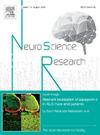SARM1 is essential for NMDA receptor-dependent endocytosis of AMPA receptors in hippocampal neurons
IF 2.3
4区 医学
Q3 NEUROSCIENCES
引用次数: 0
Abstract
Long-term depression (LTD) is a form of synaptic plasticity thought to be the cellular basis of experience-dependent learning and memory. LTD is caused by an activity-dependent decrease in cell surface α-amino-3-hydroxy-5-methyl-4-isoxazolepropionic acid (AMPA)-type glutamate receptors (AMPA receptors) at the postsynaptic sites. However, the mechanism through which AMPA receptors are removed from the cell surface via neuronal activity is not fully understood. In this study, we showed that small interfering RNA (siRNA)-mediated knockdown of sterile alpha and toll/interleukin receptor motif containing 1 (SARM1) in cultured hippocampal neurons prevented the N-methyl-d-aspartate (NMDA)-induced reduction in cell surface AMPA receptors. However, the control RNA did not affect NMDA-mediated AMPA receptor trafficking. Overexpression of the siRNA-resistant form of SARM1 in SARM1-knocked-down neurons restored AMPA receptor trafficking. However, overexpression of SARM1, which lacks the mitochondrial transport signal, in the SARM1-knocked-down neurons did not restore NMDA-dependent AMPA receptor endocytosis. Moreover, the inhibition of the NADase activity of SARM1 blocked the NMDA-induced reduction of cell surface AMPA receptors. These results suggest that both the mitochondrial localization and NADase activity of SARM1 are essential for NMDA receptor-dependent AMPA receptor internalization in the hippocampal neurons.
SARM1对海马神经元中NMDA受体依赖性AMPA受体的内吞作用至关重要。
长期抑制(LTD)是一种突触可塑性,被认为是依赖经验的学习和记忆的细胞基础。LTD是由突触后部位细胞表面α-氨基-3-羟基-5-甲基-4-异恶唑丙酸(AMPA)型谷氨酸受体(AMPA受体)的活动依赖性减少引起的。然而,AMPA 受体通过神经元活动从细胞表面移除的机制尚不完全清楚。在这项研究中,我们发现在培养的海马神经元中,小干扰 RNA(siRNA)介导的无菌α和含收费/白细胞介素受体基序 1(SARM1)的敲除阻止了 N-甲基-d-天冬氨酸(NMDA)诱导的细胞表面 AMPA 受体的减少。然而,对照 RNA 并不影响 NMDA 介导的 AMPA 受体迁移。在被 SARM1 敲除的神经元中过表达抗 siRNA 的 SARM1 可恢复 AMPA 受体的贩运。然而,在 SARM1 基因敲除的神经元中过表达缺乏线粒体转运信号的 SARM1 并不能恢复 NMDA 依赖性 AMPA 受体的内吞。此外,抑制 SARM1 的 NADase 活性阻断了 NMDA 诱导的细胞表面 AMPA 受体的减少。这些结果表明,SARM1的线粒体定位和NAD酶活性对海马神经元中NMDA受体依赖性AMPA受体内化至关重要。
本文章由计算机程序翻译,如有差异,请以英文原文为准。
求助全文
约1分钟内获得全文
求助全文
来源期刊

Neuroscience Research
医学-神经科学
CiteScore
5.60
自引率
3.40%
发文量
136
审稿时长
28 days
期刊介绍:
The international journal publishing original full-length research articles, short communications, technical notes, and reviews on all aspects of neuroscience
Neuroscience Research is an international journal for high quality articles in all branches of neuroscience, from the molecular to the behavioral levels. The journal is published in collaboration with the Japan Neuroscience Society and is open to all contributors in the world.
 求助内容:
求助内容: 应助结果提醒方式:
应助结果提醒方式:


